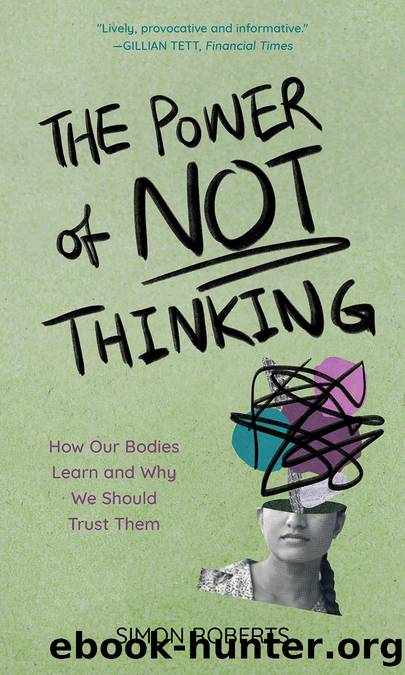The Power of Not Thinking by Simon Roberts

Author:Simon Roberts
Language: eng
Format: epub
Publisher: Rowman & Littlefield Publishers
Published: 2022-05-25T00:00:00+00:00
BODY-TO-BODY COMMUNICATION
Mirror neurons allow us to connect with other people without words and on multiple levels, so it is no surprise that the theory of mirroring has been taken up in many fields, not least by those exploring how humans communicateâand not just one-to-one, but also in groups.
Thereâs a tendency to see communication as primarily verbal. Just as the dominance of the mind in theories of intelligence led us to think of the brain as a computer that processes abstract information, so classic theories of communication saw language abilities as an artifact of the same form of processing, but of sounds and words. However, over recent decades the body has taken a more central role in research regarding language, speech, and communication.
While some researchers suggest the quantification of what proportion of our communication is verbal or nonverbal makes little sense, others have put numbers to it. The psychologist Michael Argyle estimated that more than 65 percent of information exchanged in face-to-face interaction is expressed through nonverbal means and Shuichi Nobe claims that as much as 90 percent of speech is accompanied by gestures. The psychologist Geoffrey Beattie argues that hand gestures are at the heart of communication and emerge from the same part of our brain as the semantic information (i.e., related to meaning) weâre trying to express with words. If this sounds implausible, consider the fact that even when youâre speaking on your mobile phone youâre probably using a wide array of hand gestures as you walk around the roomâeven when the other caller canât see our hand movements, we are using them to express ourselves. People who are blind from birth also use hand gestures when they speak. Whatever percentage weâre willing to allocate to each mode of communication, itâs clear that we donât use just words but also gestures, movements, and expressions to communicate with others.
The conductor Sir Simon Rattle is a maestro at using his body to communicate. Hands are key for any conductor but Rattle is legendary for seeming able to use his orchestra as if it was an instrument he was playing himself. How does he control this group of eighty or so musicians who are playing about twenty different instruments? During rehearsals a conductor uses words to communicate with the orchestra, but during a performance he is limited to nonverbal communication; he can only communicate through his body and baton and must draw out features and feeling from the score without uttering a word.
Conductors sometimes mimic the music they are conducting through bodily motions. For example, they might march when the music is a march or swing when it is a swing. On other occasions they might indicate to their orchestra that they should play softly by bending their knees, dropping down slightly, and hunching their shoulders. Guides to conducting recommend that conductors use the fact that their facial muscles can create about ten thousand different expressions. With gestures and facial expressions, a conductor can draw out subtleties and emotion for which there might not even be an obvious word to express his intent were he able to speak.
Download
This site does not store any files on its server. We only index and link to content provided by other sites. Please contact the content providers to delete copyright contents if any and email us, we'll remove relevant links or contents immediately.
Machine Learning at Scale with H2O by Gregory Keys | David Whiting(4259)
Never by Ken Follett(3884)
Harry Potter and the Goblet Of Fire by J.K. Rowling(3808)
Unfinished: A Memoir by Priyanka Chopra Jonas(3356)
Fairy Tale by Stephen King(3307)
The Man Who Died Twice by Richard Osman(3040)
Will by Will Smith(2872)
Rationality by Steven Pinker(2327)
The Dark Hours by Michael Connelly(2280)
Can't Hurt Me: Master Your Mind and Defy the Odds - Clean Edition by David Goggins(2277)
It Starts With Us (It Ends with Us #2) by Colleen Hoover(2256)
The Storyteller by Dave Grohl(2198)
Friends, Lovers, and the Big Terrible Thing by Matthew Perry(2182)
The Dawn of Everything: A New History of Humanity by David Graeber & David Wengrow(2156)
The Becoming by Nora Roberts(2151)
The Stranger in the Lifeboat by Mitch Albom(2093)
Cloud Cuckoo Land by Anthony Doerr(2060)
Love on the Brain by Ali Hazelwood(2024)
Einstein: His Life and Universe by Walter Isaacson(1985)
